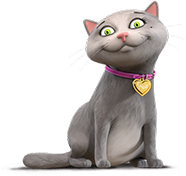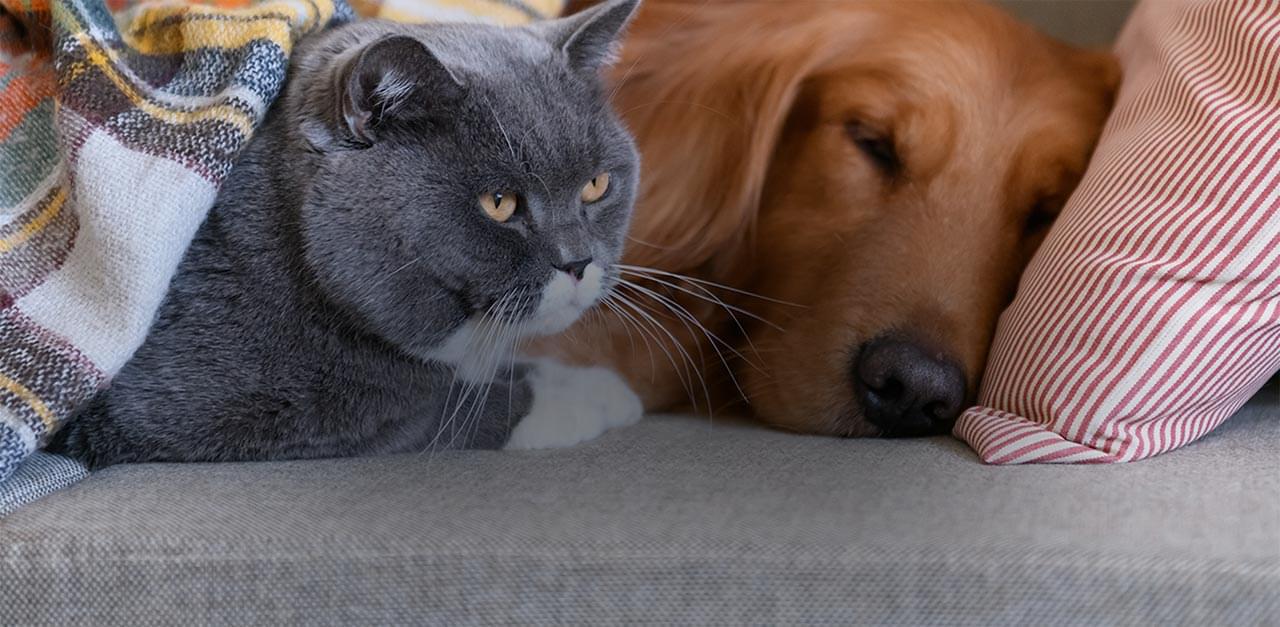Caninsulin® Frequently Asked Questions
“My pet owner has found a lot of information from here,
but they still like to ask our vet things too!”
– SUGAR

A.
Diabetes mellitus (sugar diabetes) occurs when a cat has inadequate levels of or an abnormal response to insulin, which results in excessive glucose (sugar) in the blood.
Diabetes mellitus can develop from disorders of the pancreas, from other diseases, or from the presence of other hormones.
A.
No. Diabetes insipidus, also known as water diabetes, is caused when large amounts of dilute urine are produced. It is a far less common condition than diabetes mellitus, known as sugar diabetes. Diabetes insipidus is caused by problems in part of the brain or in the kidneys. There is no glucose present in the urine of animals with diabetes insipidus.
A.
The most common signs of diabetes mellitus in cats are:
- Increased thirst
- Excessive urination
- Excessive appetite
- Weight loss despite good appetite
- Lethargy
- Failure to groom; dry, dull fur
A.
Polyuria is the production of larger than normal amounts of urine in a given period. Polydipsia is excessive thirst. Polyphagia is excessive hunger.
A.
No, your cat could have a bladder or kidney infection, or some other medical problem. If your cat is having problems holding his or her urine, you should schedule a trip to your veterinary practice as soon as possible.
A.
Your vet will measure your cat’s blood glucose and test your cat’s urine for the presence of glucose and ketones. Persistently high blood glucose levels along with glucose in the urine usually means that your cat has diabetes mellitus.
A.
Yes. Cats of all ages and breeds can get diabetes, although it most typically occurs in older cats. Obesity, genetics and other conditions can contribute to the development of diabetes.
A.
The most common problems associated with pet diabetes include recurrent infections and neuropathy in cats. Diabetic neuropathy in cats usually appears as a weakness in the hind legs. Prompt, appropriate treatment of the diabetes and the hyperglycaemia may reverse the condition.
A.
Hyperthyroidism and kidney failure are conditions that cats can get which have similar clinical signs in terms of excessive drinking, excessive urination and weight loss.
A.
No. Diabetes is due to inadequate insulin production or resistance to insulin production. Obesity is a common cause of insulin resistance in cats, as well as humans.
A.
Insulin is produced by the beta cells in the pancreas. Type 1 diabetes is characterised by the destruction of the beta cells with progressive and eventual complete loss of insulin production.
Type 2 diabetes is characterised by dysfunctional beta cells (irregular insulin production), or the other cells of the body not responding to insulin properly.
Almost all dogs have diabetes like type 1 and require insulin therapy for life. Cats can fall under type 1 or type 2 classifications and some cats therefore do not require insulin therapy for life and can go into remission after a period of treatment.
A.
With a recent shift in care for cats with diabetes, studies suggest that if a cat is monitored, and does not have any other health problems, life expectancy can be on par with other cats without diabetes. Unlike dogs, some cats may go into remission with the proper therapy and a controlled diet.
A.
Yes it is very similar, however the treatment goal may be different. The insulin, equipment and monitoring methods are specific to cats, so you must follow your vet’s advice to avoid incorrect dosing and achieve the best management possible.
A.
Caninsulin® is an insulin licensed for management of both dog and cat diabetes mellitus. It is produced by MSD Animal Health and is available by prescription only.
A.
No, Caninsulin® is registered in over 30 other countries. It was first registered in Australia in 1990, so there is a history of more than 25 years of experience with this product1.
A.
No. If Caninsulin® is diluted the dosage of insulin would be wrong.
A.
Caninsulin® is a suspension of two insulin types – an aqueous and crystalline part. Shaking is the best way to make sure these are properly mixed and that your cat receives the right amount of insulin.
Shaking should be performed on the first occasion that Caninsulin will be used to obtain a uniformly milky consistency. Thereafter before each subsequent use it should be inverted several times to obtain the same uniformly milky consistency.
A.
No, the use of a syringe other than a U-40 syringe will result in incorrect dosing and could be fatal.
A.
Your vet will prescribe the correct dose depending on your cat and will make careful adjustments based on monitoring several factors. Caninsulin is an intermediate-acting form of insulin and in cats the duration of activity is between 8-12 hours. In all cases you should follow the dosing regime advised by your vet as it will be specific to your cat.
A.
Injections should be given subcutaneously (under the skin) about 2 to 5cm (1 to 2 inches) below the spine or backbone. Constantly vary the injection location from behind the shoulder blade to just in front of the hip bone, and alternate injections between your cat’s left and right sides. Your vet or vet nurse can show you the recommended locations for injections.
Download the Administration Sheet for instructions on how to give Caninsulin® to your cat.
A.
No, freezing will damage the insulin molecules and reduce the efficacy of the product. If a vial of insulin accidentally freezes in the refrigerator, it should be discarded and a new vial should be used.
A.
Unopened Caninsulin® vials and cartridges should be refrigerated (between+2 and +8°C). Once opened, broached Caninsulin vials and cartridges can be stored at up to 25°C for up to 42 days.
A.
- Always have a spare vial or cartridge on hand
- Protect it from light
- Keep it refrigerated before opening, and below 25°C after opening.
- If it has got too hot, or frozen, discard it immediately
- Discard contents after 42 days of the first vial puncture or first use of cartridge
- Before drawing up a dose, shake the vial or the VetPen loaded with cartridges until a homogeneous, uniformly milky suspension is obtained
A.
All syringes should be disposed of in an appropriate sharps/biohazard container.
1. Caninsulin Summary of Product Characteristics (SPC).
A.
While insulin pens have been commonly used in the management of human diabetes for some time, VetPen is the first device designed for use in cats and dogs with diabetes. Previously, the only approved way to give Caninsulin® injections was to use vials and syringes, which some pet owners found inconvenient and overwhelming. While human insulin pens are used to give insulin with a concentration of 100 IU per ml, VetPen works specifically with 40 IU per ml Caninsulin®, which is tailor-made for use in pets.
A.
VetPen is ergonomically designed to make handling easy and the dosing process simple. It also reduces the time it takes to prepare and give insulin injections. It’s easy enough to use even for a pet owner who have poor eyesight, arthritis, or any other condition that may cause unsteady hands.
A.
VetPen uses 29 gauge, 12mm pen needles only, which are small, thin, and specially lubricated. These are the only needles that should be used with VetPen. Always use a new needle for each injection.
A.
A new needle should be used with each injection. The needle should be removed with the needle remover and safely disposed of immediately after use. Reusing a needle may lead to blunting of the needles, insulin contamination, needle blockage, and/or inaccurate dosing.
A.
Yes. VetPen uses a replaceable insulin cartridge that allows multiple doses to be provided with minimal preparation time. When all the insulin has been used, simply remove the empty cartridge and insert a new one. After inserting a new cartridge, it is important to prime the VetPen prior to use. (See instructions for Priming the VetPen)
A.
VetPen has been designed specifically for use with Caninsulin®. To avoid dosing errors, other types of insulin cartridges for other types of insulin should not be used with VetPen.
A.
VetPen helps enhance use by:
- Protecting the insulin cartridge from breakage
- Reducing the likelihood of insulin spills
- Reducing air bubbles that lead to inaccurate dosing
- Selecting doses more accurately
A.
Each cartridge contains 2 glass beads to help with the mixing of the Caninsulin® before use. The cartridge should be thoroughly shaken before inserting it into the VetPen. After shaking, the insulin should appear uniformly milky. Do not use the cartridge if clumps persist after shaking thoroughly. Do not mistake the glass mixing beads for air bubbles, which should be removed during priming.
A.
To make sure the pet’s dose is injected precisely and accurately, you need to hold down the release button until the arrow (![]() ) points to the start line (–) on the dose selector. Then, wait at least 5 seconds before removing the needle from the skin. This allows for VetPen’s internal mechanism to optimally deliver the selected dose.
) points to the start line (–) on the dose selector. Then, wait at least 5 seconds before removing the needle from the skin. This allows for VetPen’s internal mechanism to optimally deliver the selected dose.
A.
Always check to ensure there is enough insulin in the cartridge before injection.
After injection, the arrow on the dose selector should point to the start line (-). If not, it may indicate how many units of the dose were not given, but there can be other reasons for this.
Write down the number it stopped at and contact your vet for advice as too much insulin could cause your pet to have dangerously low blood sugar. A brief period of high blood sugar (hyperglycaemia) due to too low insulin dose is not as dangerous as the possibility of causing low blood sugar (hypoglycaemia) by giving too much insulin.
A.
VetPens should always be stored or carried with the needle removed and the cap on. To clean your VetPen, simply wipe with a damp cloth. Do not immerse it in water. Keep Caninsulin® cartridges refrigerated and protected from light prior to use. After first use store below 25°C for up to 42 days. Do not freeze.
A.
If you are experiencing any issues using VetPen, the first step is to confirm that air was properly removed from the cartridge through priming. If this has been done, check the other Q&As for more troubleshooting help, or contact your veterinary clinic.
A.
This may be a sign the needle may have been removed before the injection was completed, and your cat did not receive the full dose. Do not attempt to re-dose your cat until she is due for their next injection.
To make sure your pet receives his or her full dose, be sure to press the release button down fully and hold it until the arrow (![]() ) points to the start line (–) on the dose selector. Then, to allow the VetPen to deliver the full dose, wait at least 5 seconds before removing the needle from the skin.
) points to the start line (–) on the dose selector. Then, to allow the VetPen to deliver the full dose, wait at least 5 seconds before removing the needle from the skin.
A.
There are 4 likely causes for this:
- The release button is not fully pushed toward the needle. This can prevent the dose from being released completely. Be sure to push the release button down fully during each injection so that the dose selector can rotate back to the start line. Then, wait at least 5 seconds before removing the needle.
- You’re closing your hand too tightly around the dose selector. This can prevent it from fully rotating back to the start line. Avoid this by holding the VetPen like a pen so that the dose selector is able to rotate freely after the release button has been depressed.
- The needle is blocked. Replace the needle on VetPen with a new one. It is important to use a new needle for each injection for hygiene and safety reasons.
- The cartridge did not have enough insulin for the full dose. If the cartridge is empty, replace it with a new one and complete the priming process.
A.
If too high a dose has been selected, it is very important not to try to turn the dose selector back to a lower dose. This can damage or break the VetPen. Instead, release the insulin through the needle into a tissue or swab by pressing the release button. Then select the correct dose.
A.
There are 2 likely causes for this:
- The needle is blocked. To fix, replace the needle with a new one. Remember to use a new needle for each injection.
- The cartridge plunger is stuck. To fix this, place the protective cap back onto the needle and unscrew the cartridge holder. Then slide the release button towards the internal plunger and hold it until the arrow points to the start line. Dial 2 units without screwing the device back together, then push and hold down the release button until the arrow points to the start line. Without rewinding the internal plunger, screw the cartridge holder and the VetPen body back together. This should release the cartridge plunger and expel some of the insulin.
A.
If you missed a full or partial dose, it is best to wait until the next insulin dose is required and then continue as normal. A brief period of high blood sugar (hyperglycaemia) due to too low an insulin dose is not as dangerous as the possibility of causing low blood sugar (hypoglycaemia) by giving too much insulin. If you have worries contact your vet.
A.
Contact your veterinary practice and explain the situation. Your veterinary practice may recommend feeding your cat extra food. Monitor your cat carefully for signs of low blood sugar (hypoglycaemia):
- Hunger
- Restlessness
- Shivering
- Unsteadiness
- Very quiet or sleepy
If you see any of these signs, try to encourage your cat to eat a small meal, or rub some honey or jam on your cat’s gums and contact your veterinary clinic.
A.
The following signs may indicate hypoglycaemia:
- Restlessness
- Trembling or shivering
- Unusual movements or behaviour
- Unusual quietness or sleepiness
- Loss of consciousness (coma)
If you notice any of these signs, contact your veterinary surgery. If your cat is conscious, you should immediately treat your cat by pouring a small amount of a sugar solution (like honey) onto your finger and then rubbing it onto your cat’s gums. The sugar is absorbed very quickly and your cat should respond in 1–2 minutes. The sugar solution should never be poured directly into your cat’s mouth since there is a risk that the solution will be inhaled into the lungs. Once your cat has responded to the sugar administration and is sitting up, it can be fed a small meal. Once stabilised, your cat should be transported to your veterinary practice for evaluation.
A.
Stress hyperglycaemia describes the situation where blood glucose becomes elevated due to stress. Even healthy cats develop (sometimes very high) levels of blood glucose in their blood temporarily due to the release of certain hormones (e.g. adrenaline) during stress responses. Since handling may be sufficient to induce sufficient stress and affected cats may not outwardly look anxious this can complicate both the diagnosis and monitoring of diabetes in some cats. This can mean that other tests that give a better measure of how glucose changes over a longer period such as fructosamine or continuous tissue glucose monitoring using an adhesive sensor may prove more useful in many individuals.
A.
Fructosamine is a type of protein in the blood that can be used to measure glucose control over a longer period. Unlike blood glucose measurements, fructosamine is not affected by stress or the timing of the insulin injection. Your veterinary practice may recommend periodic measurements of fructosamine to evaluate how well your pet’s blood glucose level has been controlled over the last few weeks.
A.
You should always make sure your cat has constant access to fresh water. Monitoring how much they are drinking at home is a really good way of seeing how controlled they are. One of the classic clinical signs of diabetes is excessive drinking, but you should notice this settle to a more normal level once controlled (40-100ml/kg). If their drinking increases at any point, this could be a sign they are not ideally controlled, or they have a secondary issue, so keep a record if you can and contact your vet if you notice your cat drinking excessively.
A.
If diabetes is left untreated or unregulated it could cause many complications. These include neuropathy, infections, ketosis, and ultimately death.
A.
There is no way to put a specific time on it since each cat is different. Sometimes the stabilisation process will require you to try different insulin dosages, diets, or management alterations. Stabilisation can be achieved sometimes within a month, or other times over a year from when therapy first started. It is very important to work closely with your vet and vet nurse team during this process to avoid further complications. Even after your cat is stabilised, frequent vet visits will be necessary to maintain good health.
A.
Your vet will be the best person to advise you on the most appropriate diet for your cat. Remember consistency is key with diet, so the aim is keep the volume, frequency and timing of their diet the same each day to avoid any changes in insulin needs. Speak to your vet to find out about appropriate treats your pet could still enjoy!
A.
To keep constant from day to day, it is best to use commercially produced rather than homemade foods. Certain high protein, low carbohydrate prescription veterinary diets are a useful adjunct to insulin therapy. If special diets are unavailable, or your cat does not eat the diets, then standard canned cat foods are acceptable.
A.
This is where the blood glucose is measured every 1-2 hours throughout the day. This is usually performed at the vets but can be done at home. If at the vets, the cat should be on the same food schedule as at home. For most cats, a 10–12 hour curve is adequate but in some instances a longer curve may be needed. A glucose curve helps you see insulin effectiveness, glucose nadir (the lowest glucose reading), and duration of insulin effect. The insulin dose, frequency of administration and feeding times may be altered based on these results combined with clinical signs (e.g. weight, appetite, thirst, urination, demeanour).
A.
The results of a curve can be affected by several factors such as appetite and stress, so your vet will advise if it is the best monitoring tool and whether it needs to be done in clinic or at home. If your cat won’t eat at the clinic, your vet will advise you to feed your cat before they arrive at the clinic for their blood glucose curve.
Along with appetite and stress, other factors that can affect blood glucose curves also include digestion, metabolism, exercise and hormones, even in well regulated cats. This means the results can vary day to day. Your vet will interpret the results in combination with clinical signs you report.
A.
This will vary depending on your cat and your circumstances, so your vet will be the best person to advise the best frequency.
A.
If your cat is not eating do not give Caninsulin® or any other insulin! If your cat has a reduced appetite, consult your vet on how to proceed with insulin injections.
A.
Ideally your cat would eat before you give the insulin injection, however some owners find it easier to give the injection as their cat is eating, and this is also okay. If your cat doesn’t eat their whole meal straight away and tends to graze throughout the day then this is not a problem. Speak to your vet or vet nurse about the best feeding schedule for your cat.
A.
If healthy and well stabilised, most experts recommend every three to six months, but your veterinary practice will recommend what is best for your cat.
A.
It is perfectly safe for a cat with diabetes to receive vaccinations. In fact, it is important to help prevent infectious diseases in your diabetic pet, and this annual visit also gives your vet a good opportunity to give your cat a complete checkup. By keeping your cat healthy, there will be fewer fluctuations in their insulin requirements.
A.
Normally animals need to have an empty stomach before they are anaesthetised. A cat with diabetes that has not been fed needs far less insulin. Your vet will advise you on how to manage your cat’s diabetes if it needs to have an anaesthetic. Usually a cat with diabetes is administered intravenous fluid therapy while under anaesthesia. This hydrates the animal when it cannot drink on its own. If stable, your cat is not at any additional risk from anaesthesia than a cat without diabetes of the same age.

Talk to Your Vet Today
to learn more about pet diabetes, and how cats and dogs can lead a happy,
healthy life with proper management
Caninsulin® 40 IU/ml Suspension for Injection contains porcine insulin. POM-V.
Further information is available from the SPC, Datasheet or package leaflet.
Advice should be sought from the medicine prescriber.
Prescription decisions are for the person issuing the prescription alone.
Use Medicines Responsibly.



